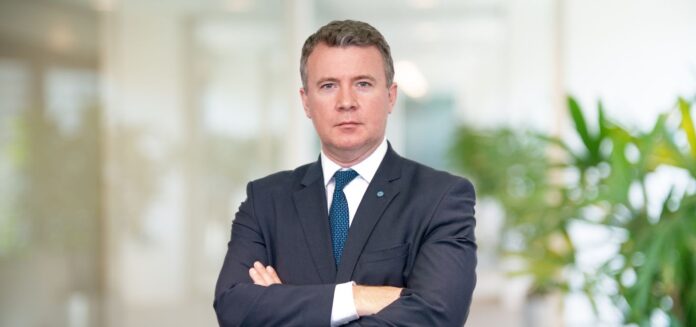Brian O’Reilly, head of investment strategy at Mediolanum International Funds, discusses his 25 years in investment management, his journey from Goldman Sachs and UBS to Davy and his role in shaping Mediolanum’s investment house view.
With your extensive background, how do you shape Mediolanum International Funds’ investment house view amidst the current market trends?
The essence of asset allocation is understanding the economic cycle and identifying which assets excel in various environments. Each cycle is unique, yet they share common patterns. Mediolanum International uses a proprietary cycle indicator that has tracked these patterns since the 70s. It helps it ascertain if it is in a cycle’s late or early stages.
Today, we’re in a late cycle, evident from metrics like low unemployment and high consumer spending. Historically, equities, commodities and growth-focused investments like technology performed well during this phase, which is what Mediolanum International is seeing this year. However, vigilance is essential as the cycle can transition, necessitating changes in its house view and tactical asset allocation. The cornerstone of an influential house view is comprehending the economic and investment cycle’s position.
Your tenure as CIO at both UBS Wealth Management and Davy must have given you diverse experiences. How did the strategies at these firms shape your perspective at Mediolanum International?
Both firms vary significantly. Davy is an important wealth manager in Ireland with 15 billion under management and 700 people, but contrasts sharply with UBS’s global stature, with over $2 trillion in assets and 70,000 employees.
At UBS, each major region had a dedicated CIO, and combined expertise surpassed 200 members. This network was especially beneficial during crises like the global financial downturn, enabling 24/7 global communication.
In contrast, at Davy, the challenge was transitioning from a resource network to a more localised one but still having a global focus. To bridge this gap, Davy prioritised creating tools like the cycle indicator and macro monitor, which consolidate vast data into pivotal indicators. The experience of moving from a global firm to a localised entity and then integrating those learnings into Mediolanum International has underscored the importance of efficiency, self-reliance and focusing on what truly matters.
At Mediolanum’s investment committee, how do you align short-term market reactions with the company’s long-term strategic goals?
Mediolanum International employs a dual approach. Firstly, its strategic asset allocation for funds emphasises its clients’ long-term goals. For instance, if it designs a multi-asset fund based on a 50% equity and 50% fixed income model, it has higher confidence in the projected annualised returns over a 10-15-year period than the next 1-2 years. This strategic allocation needs clarity and consistency. Major deviations can lead to errors. For example, statistics reveal that missing only a few of the market’s best days can significantly diminish returns compared to enduring market highs and lows. So, staying invested is critical to achieving long-term goals.
As an analogy, an interesting way to think about asset allocation is like sailing, where you can compare different approaches to strategic asset allocation and tactical asset allocation. In sailing, there are multiple ways to reach a destination. One method is to simply set your sails and cruise steadily to your waypoint, making only minor adjustments as conditions dictate to keep you on course (think of rebalancing a portfolio annually), synonymous with Mediolanum International’s strategic asset allocation. Tactical asset allocation involves assessing the most recent information available and making adjustments to your portfolio and sails based on those changing conditions or tacking to wind shifts, which is Mediolanum International’s tactical asset allocation.
Of course, if a major storm is coming, like a recession, it makes sense to adjust your course and head for safe harbours if warranted (like changing the allocation between equities and bonds). This is the real benefit of tactical asset allocation to help investors protect their wealth in difficult periods or, in a worst-case scenario, to ensure they keep their boat afloat.
So, while Mediolanum International’s primary focus remains on strategic allocation, it adjusts its portfolios based on its cycle indicator for wind shifts and looming recessions. Also, it doesn’t typically react to short-term events, like geopolitical incidents, since history suggests such reactive moves can be counterproductive. For example, while events like Brexit garnered lots of attention, global economic cycles weren’t halted.
Given the rapid evolution of global markets, what trends do you foresee dominating the next decade, and how is Mediolanum International positioning itself to capitalise on these?
I think Mediolanum International is at a very interesting juncture. Today, there are both parallels to the 1970s when geopolitical tensions sent oil prices soaring, leading to high inflation, and the 1990s with the advent of new technologies like the internet, which created a huge productivity shift and strong economic growth. Think of today with the introduction of AI and the efficiency improvements in renewable energy technology.
So, Mediolanum International is positioning itself for a period when inflation remains elevated, interest rates remain high and a productivity shift from new technologies. For example, it can now invest in safe-haven assets like government bonds.
In parallel, Mediolanum International is investing in the secular trends that are taking place, like AI and the energy transition. It is also positioning itself for the amounts of investment governments have committed to the energy transition in the coming decade and the companies to build out that infrastructure in a number of industries like wind, solar, battery technology and hydrogen, etc.
© Funds Europe 2023





